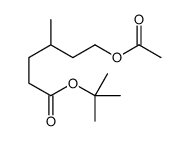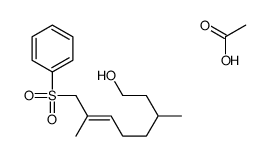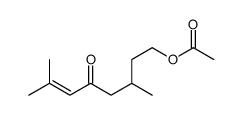dl-Citronellol acetate

dl-Citronellol acetate structure
|
Common Name | dl-Citronellol acetate | ||
|---|---|---|---|---|
| CAS Number | 150-84-5 | Molecular Weight | 198.302 | |
| Density | 0.9±0.1 g/cm3 | Boiling Point | 258.5±19.0 °C at 760 mmHg | |
| Molecular Formula | C12H22O2 | Melting Point | N/A | |
| MSDS | Chinese USA | Flash Point | 88.2±19.9 °C | |
Use of dl-Citronellol acetateCitronellyl acetate is a monoterpene product of the secondary metabolism of plants, with antinociceptive activity. Citronellyl acetate exhibits pro-apoptotic activity in human hepatoma cells. Citronellyl acetate shows fungicidal, larvicidal, bactericidal and repelling/insecticidal effects[1]. |
| Name | citronellol acetate |
|---|---|
| Synonym | More Synonyms |
| Description | Citronellyl acetate is a monoterpene product of the secondary metabolism of plants, with antinociceptive activity. Citronellyl acetate exhibits pro-apoptotic activity in human hepatoma cells. Citronellyl acetate shows fungicidal, larvicidal, bactericidal and repelling/insecticidal effects[1]. |
|---|---|
| Related Catalog | |
| References |
| Density | 0.9±0.1 g/cm3 |
|---|---|
| Boiling Point | 258.5±19.0 °C at 760 mmHg |
| Molecular Formula | C12H22O2 |
| Molecular Weight | 198.302 |
| Flash Point | 88.2±19.9 °C |
| Exact Mass | 198.161987 |
| PSA | 26.30000 |
| LogP | 4.28 |
| Vapour Pressure | 0.0±0.5 mmHg at 25°C |
| Index of Refraction | 1.442 |
| Water Solubility | PRACTICALLY INSOLUBLE |
CHEMICAL IDENTIFICATION
HEALTH HAZARD DATAACUTE TOXICITY DATA
|
| Personal Protective Equipment | Eyeshields;Gloves;half-mask respirator (US);multi-purpose combination respirator cartridge (US) |
|---|---|
| Safety Phrases | S24/25 |
| RIDADR | NONH for all modes of transport |
| WGK Germany | 2 |
| RTECS | RH3422500 |
| HS Code | 2915390090 |
| HS Code | 2915390090 |
|---|---|
| Summary | 2915390090. esters of acetic acid. VAT:17.0%. Tax rebate rate:13.0%. Supervision conditions:AB(certificate of inspection for goods inward,certificate of inspection for goods outward). MFN tariff:5.5%. General tariff:30.0% |
|
Bio-degradation of acetates of geraniol, nerol & citronellol by P. incognita: isolation & identification of metabolites.
Indian J. Biochem. Biophys. 20(3) , 136-40, (1983)
|
|
|
Pesticide determination in rose petals using dispersive solid-phase extraction followed by gas chromatography-tandem mass spectrometry.
Anal. Bioanal. Chem 406(30) , 8041-8, (2014) Damascena and centifolia roses are cultivated worldwide for their petal extracts that contain key odorant ingredients of perfumes. The analytical identification and quantification of pesticides in ros... |
|
|
Behavior of Multiclass Pesticide Residue Concentrations during the Transformation from Rose Petals to Rose Absolute.
J. Agric. Food Chem. 63 , 4922-32, (2015) This study investigates the concentrations of 54 multiclass pesticides during the transformation processes from rose petal to concrete and absolute using roses spiked with pesticides as a model. The c... |
| 3,7-Dimethyl-6-octen-1-yl acetate |
| Citronellyl acetate |
| 3,7-Dimethyloct-6-en-1-yl acetate |
| 6-Octen-1-ol, 3,7-dimethyl-, acetate |
| MFCD00015039 |
| 8-Acetoxy-2,6-dimethyl-2-octene |
| 3,7-Dimethyl-6-octen-1-ylacetat |
| EINECS 205-775-0 |
| Acétate de 3,7-diméthyl-6-octèn-1-yle |
| 3,7-Dimethyl-6-octen-1-ol Acetate |
| (±)-Citronellyl acetate |
| dl-Citronellol acetate |
| β-Citronellyl acetate |
 CAS#:79-21-0
CAS#:79-21-0 CAS#:64-19-7
CAS#:64-19-7 CAS#:67416-62-0
CAS#:67416-62-0 CAS#:90165-56-3
CAS#:90165-56-3 CAS#:60857-06-9
CAS#:60857-06-9